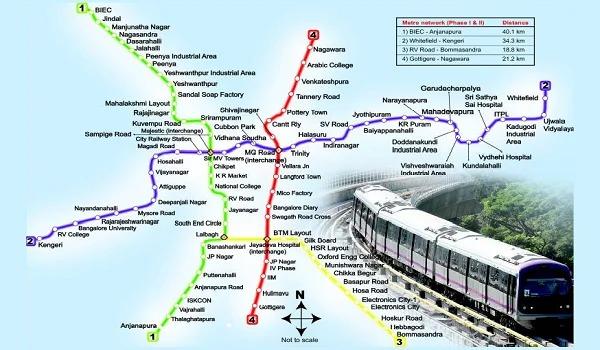Navigating Bengaluru's bustling streets has become more efficient with the advent of Namma Metro, the city's rapid transit system. This comprehensive guide delves into the Bangalore Metro Route Map, detailing its lines, stations, and future developments to assist commuters in planning their journeys effectively.
Overview of Namma Metro
Namma Metro, translating to "Our Metro" in Kannada, serves as a pivotal component of Bengaluru's public transportation network. Since its inauguration in 2011, it has significantly alleviated traffic congestion, offering a reliable and eco-friendly alternative to road transport.
Current Operational Lines
Purple Line
Stretching from Whitefield (Kadugodi) in the east to Challaghatta in the southwest, the Purple Line spans approximately 43.49 kilometers and encompasses 37 stations. This line facilitates east-west connectivity, linking key areas such as MG Road, Indiranagar, and Vijayanagar.
Green Line
The Green Line currently connects Nagasandra in the northwest to Silk Institute in the southwest, covering a distance of about 30.5 kilometers with 29 operational stations. Upon completion of Phase 2, the line will extend to Madavara, increasing its length to 34.46 kilometers and adding three more stations.
Upcoming Lines Under Construction
Yellow Line
The Yellow Line, under Phase 2, will connect Rashtreeya Vidyalaya Road to Bommasandra, covering 18.82 kilometers with 16 stations. This line aims to enhance connectivity to Electronic City and the Bommasandra industrial area. Completion is anticipated by February 2024.
Pink Line
Extending from Kalena Agrahara in the south to Nagawara in the north, the Pink Line will span 21.25 kilometers and include 18 stations. This line is expected to be operational between December 2024 and 2026, improving north-south connectivity.
Blue Line
Also known as the ORR-Airport Metro Line, the Blue Line will connect Central Silk Board with Kempegowda International Airport, covering 58.19 kilometers and comprising 30 stations. Phase 2A (Silk Board to KR Puram) is slated for completion by June 2025, while Phase 2B (KR Puram to Airport) is expected by June 2026.
Future Plans and Extensions
Orange Line
As part of Phase 3, the proposed Orange Line will connect Kempapura to JP Nagar 4th Phase along the Outer Ring Road-West, spanning approximately 32.2 kilometers with 22 stations. Completion is projected by 2028.
Additional Proposed Lines
Plans are underway to extend metro services to outlying towns such as Doddaballapur, Nelamangala, Devanahalli, and Hoskote, aiming to reduce traffic congestion and bolster regional connectivity.
Benefits of Namma Metro
-
Time Efficiency: Significantly reduces travel time compared to traditional road transport.
-
Eco-Friendly: Contributes to lowering Bengaluru's carbon footprint through sustainable practices.
-
Cost-Effective: Offers affordable travel options, including monthly passes for frequent commuters.
-
Safety and Comfort: Equipped with features like dedicated women's coaches and CCTV surveillance to ensure passenger safety.
Challenges and Considerations
Despite its advantages, Namma Metro faces challenges such as overcrowding during peak hours and construction delays in extending metro lines. Addressing these issues is crucial for enhancing the overall commuter experience.
Metro Station Amenities and Facilities
Smart Ticketing System
Namma Metro has introduced a smart ticketing system, enabling commuters to use QR code-based tickets and digital wallets for hassle-free transactions. This initiative minimizes wait times at ticket counters and enhances convenience.
Feeder Bus Services
To improve last-mile connectivity, BMTC operates feeder buses from major metro stations. These buses link residential neighborhoods, IT hubs, and commercial areas, ensuring smooth transitions between metro and road transport.
Parking Facilities
Several metro stations offer parking spaces for two-wheelers and four-wheelers, making it easier for commuters to integrate metro travel with personal vehicle use. The availability of secure parking encourages more people to opt for metro services.
Accessibility Features
Stations are equipped with escalators, elevators, and tactile pathways to ensure accessibility for elderly passengers and individuals with disabilities. Dedicated seating and priority boarding areas further enhance travel convenience.
Metro’s Role in Bengaluru’s Growth
Boosting Real Estate Development
Proximity to metro corridors has increased demand for residential and commercial properties. Areas near metro stations have witnessed significant infrastructure development, attracting businesses and homebuyers alike.
Enhancing Urban Mobility
The metro system integrates seamlessly with Bengaluru's transport ecosystem, reducing dependency on private vehicles and easing road congestion. By promoting public transport, Namma Metro contributes to sustainable urban development.
Supporting Economic Growth
Improved connectivity fosters economic activities by linking business districts, IT hubs, and industrial zones. The metro system enables efficient workforce mobility, benefiting companies and employees across the city.
Future Prospects for Namma Metro
Expanding Coverage
With Phase 3 planning in progress, metro services will soon reach underserved areas, bridging transit gaps and supporting Bengaluru’s rapid expansion. Authorities continue to explore new routes and extensions to accommodate growing commuter demands.
Integrating with Other Transport Modes
Efforts are underway to integrate metro services with suburban rail, bus networks, and other transportation systems. This multimodal approach aims to streamline travel experiences and encourage public transport adoption.
Advancing Green Initiatives
Namma Metro is committed to sustainability by incorporating energy-efficient technologies and solar power in station operations. Plans to enhance green spaces around metro corridors further align with Bengaluru’s environmental goals.
Conclusion
Namma Metro has transformed urban mobility in Bengaluru, offering a fast, efficient, and sustainable mode of transportation. As new lines and extensions continue to expand the network, commuters will benefit from enhanced connectivity across the city. The integration of smart ticketing, feeder buses, and accessibility features ensures a seamless travel experience for all. While challenges like congestion and construction delays persist, continuous improvements and future expansions will solidify Namma Metro’s role as a vital pillar of Bengaluru’s transport infrastructure. Choosing metro travel not only saves time and money but also contributes to a greener and more sustainable urban future.
For personalized assistance or inquiries, feel free to contact us.
Frequently Asked Questions
1. What are the operational hours of Namma Metro?
Namma Metro operates from approximately 5:30 AM to 11:00 PM, with variations based on line and station.
2. How can I purchase a metro ticket?
Commuters can buy tickets through token vending machines, smart cards, and mobile QR-based ticketing systems.
3. Are there any discounts available for metro fares?
Discounts are offered on smart card usage, and concessional fares are available for senior citizens and students.
4. Does Namma Metro provide connectivity to the airport?
The upcoming Blue Line will connect the city to Kempegowda International Airport by 2026.
5. What is the frequency of metro trains?
Metro trains run at intervals of 5 to 15 minutes, depending on the time of day and line congestion.
6. Are feeder buses available at metro stations?
Yes, BMTC operates feeder buses from key metro stations to improve last-mile connectivity.
7. Is parking available at metro stations?
Many stations offer parking facilities for two-wheelers and four-wheelers at designated lots.
8. How safe is Namma Metro for women and elderly passengers?
The metro system includes CCTV surveillance, dedicated women's coaches, and priority seating for safety and convenience.
9. Can I carry luggage on the metro?
Passengers can carry small luggage, but restrictions apply to large or hazardous items.
10. Are metro stations accessible for differently-abled individuals?
Yes, stations are equipped with ramps, elevators, and tactile pathways to assist differently-abled passengers.



